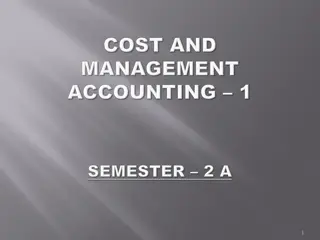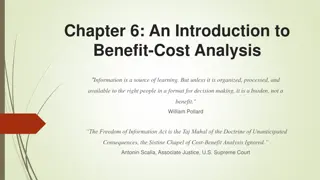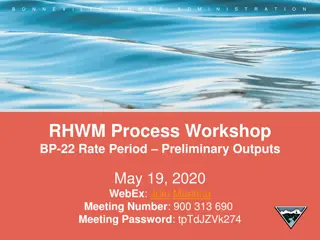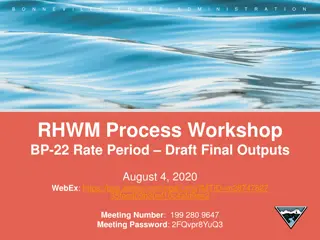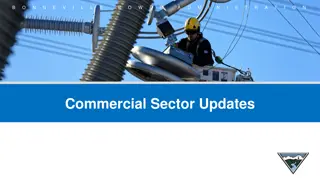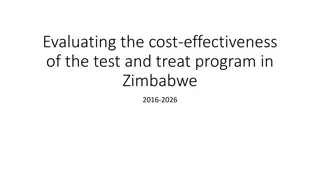Bonneville Power Administration Resource Program and Cost Effectiveness
"Explore Bonneville Power Administration's resource program, cost effectiveness, and energy efficiency action plan through a series of findings, reviews, and solutions. Delve into portfolio optimization steps, risk minimization strategies, and preliminary resource solutions to drive cumulative energy savings. Understand the impact of diverse resources like renewables and demand response in achieving energy targets."
Download Presentation

Please find below an Image/Link to download the presentation.
The content on the website is provided AS IS for your information and personal use only. It may not be sold, licensed, or shared on other websites without obtaining consent from the author.If you encounter any issues during the download, it is possible that the publisher has removed the file from their server.
You are allowed to download the files provided on this website for personal or commercial use, subject to the condition that they are used lawfully. All files are the property of their respective owners.
The content on the website is provided AS IS for your information and personal use only. It may not be sold, licensed, or shared on other websites without obtaining consent from the author.
E N D
Presentation Transcript
B O N N E V I L L E P O W E R A D M I N I S T R A T I O N Resource Program, Cost Effectiveness and EE Action Plan
B O N N E V I L L E P O W E R A D M I N I S T R A T I O N A Review of Resource Program Findings
B B O O N N N N E E V V I I L L L L E E P P O O W W E E R R A A D D M M I I N N I I S S T T R R A A T T I I O O N N 2022 Resource Program Process Draft - For Discussion Purposes Only 3
B B O O N N N N E E V V I I L L L L E E P P O O W W E E R R A A D D M M I I N N I I S S T T R R A A T T I I O O N N Refresher: Portfolio Optimization Step 1: Find Portfolio 1, the least-COST mix of resources that meet P10 HLH Energy needs and don t violate Market Purchase Limit Total Risk by Portfolio 1100 Total Risk (Vairance in Total Cost) 1050 1000 Step 2: Find Portfolio 40, the least-RISK* mix of resources that meet P10 HLH Energy needs and don t violate Market Purchase Limit 950 900 850 Step 3-40: Incrementally add budget to Portfolio 1 s budget value and remix resources to find risk minimizing combination at given budget level 800 750 700 1 3 5 7 9 11 13 15 17 19 21 23 25 27 29 31 33 35 37 39 *Risk is the variance in total portfolio cost across iterations, with expected resource costs and expected market prices causing most of the variance Portfolio Number Total_Risk Draft - For Discussion Purposes Only 4
B B O O N N N N E E V V I I L L L L E E P P O O W W E E R R A A D D M M I I N N I I S S T T R R A A T T I I O O N N Preliminary Resource Solutions Summary EE aMWs are consistent with Council target in Power Plan. DR shows up as a regularly deployed, low impact, low cost energy related load management product. Renewables are selected to reduce volatility in risk reducing scenarios, highlighting the potential benefit of resource diversity from potential thin-market futures. Draft - For Discussion Purposes Only 5
B B O O N N N N E E V V I I L L L L E E P P O O W W E E R R A A D D M M I I N N I I S S T T R R A A T T I I O O N N EE Results and Comparison to 2020 2022RP Cumulative Savings (aMW) 2020RP Cumulative Savings (aMW) 2-year 4-year 10-year 2-year 4-year 10-year Portfolio 1 96 223 723 Portfolio 1 111 229 506 Portfolio 2 103 242 785 Portfolio 2 123 250 501 Portfolio 3 105 245 787 Portfolio 3 126 256 505 Draft - For Discussion Purposes Only 6
B B O O N N N N E E V V I I L L L L E E P P O O W W E E R R A A D D M M I I N N I I S S T T R R A A T T I I O O N N Comparison to Council s 2021 Power Plan The 2022 Resource Program uses updated EE supply curves from the 2021 Plan BPA s market price forecast, needs assessment, market purchase limits 2022 RP, Portfolio 1 EE Savings over 2021 Plan Timeline: Corresponding to NWPCC 2021 Plan Timeline (Cumulative aMW of EE) 2022* 2023* 2022 RP Port 1 38 76 2024 119 2025 171 2026 231 2027 299 NWPCC 2021 Draft Plan EE target for BPA is 270-360 cumulative aMW by 20271 1Source: NWPCC 2021 Draft Plan, Section 8. https://www.nwcouncil.org/sites/default/files/2021powerplan_2021-5.pdf *Represents anticipated EE acquisitions for 2022 and 2023, prior to 2022 RP study horizon Draft - For Discussion Purposes Only 7
B B O O N N N N E E V V I I L L L L E E P P O O W W E E R R A A D D M M I I N N I I S S T T R R A A T T I I O O N N Demand Response in 2022 RP Least-cost DR totals are mainly comprised of four products: DVR, and Residential, Commercial, and Industrial CPP programs. Demand Response Capacity (Peak MW) Portfolio Season 2-year 4-year 10-year DVR comprises roughly half of the total for the 2- year and 4-year periods. Summer 213 436 371 1 Winter 158 283 243 Risk-reducing portfolios start to add other DR products Summer 213 474 488 2 Portfolio 1 acquires DVR and CPP And winter residential BYOT in 2033 Winter 158 283 260 Summer 213 474 488 3 Portfolios 2 and 3 acquire those and additionally Residential Summer TOU in 2024 Winter 158 283 260 Draft - For Discussion Purposes Only 8
B O N N E V I L L E P O W E R A D M I N I S T R A T I O N What was Picked: Resource Program and Power Plan,
Residential by End Use 2022 2023 2024 2025 2026 2027 Portfolio 1 Water Heating HVAC Electronics Lighting Refrigeration Food Preparation Other Subtotal Incremental Portfolio 2 Water Heating Food Preparation Subtotal Portfolio 1 & 2 Total 1.9 3.3 0.3 0.4 0.1 0.0 0.0 5.9 3.4 4.2 0.5 0.7 0.2 0.0 0.0 8.9 5.1 5.5 0.9 0.9 0.2 0.0 0.0 12.6 7.1 7.0 1.3 1.1 0.3 0.0 0.0 16.8 9.4 8.7 1.7 1.3 0.4 0.0 0.0 21.5 11.8 10.8 2.3 1.6 0.5 0.0 0.0 26.9 0.1 0.0 0.1 6.0 0.2 0.0 0.2 9.1 0.3 0.0 0.3 12.9 0.4 0.0 0.4 17.2 0.6 0.0 0.6 22.1 0.7 0.0 0.7 27.6 10
Residential Measures Selected by Resource Program and Power Plan RP PP BOTH Heat Pump Water Heaters Clothes Washers Smart Thermostats Televisions Thermostatic Valves Some Insulation EV Chargers Some Windows Lamps/Fixtures Clothes Dryers Some Fridges/Freezers Duct Sealing Some DHPs Cooking Power Strips NEITHER Air Sealing Behavior ASHPs = Additional Portfolio 2 Selections Note: These lists should be interpreted as indicative of general trends, as some measures have many variations with potentially different results. 11
Commercial by End Use Portfolio 1 2022 2023 2024 2025 2026 2027 Lighting Electronics Refrigeration HVAC Motors/Drives Food Preparation Process Loads Water Heating Whole Bldg/Meter Level Subtotal 13.4 1.8 1.3 0.9 0.5 0.2 0.4 0.1 0.0 18.4 13.9 2.6 1.6 1.1 0.6 0.3 0.5 0.2 0.0 20.9 14.6 3.1 2.1 1.3 0.8 0.5 0.6 0.3 0.0 23.3 15.2 3.5 2.6 1.6 1.0 0.7 0.7 0.4 0.1 25.7 14.9 3.7 3.1 1.9 1.3 0.9 0.8 0.5 0.1 27.1 14.7 3.7 3.7 2.2 1.6 1.1 0.9 0.6 0.2 28.7 Incremental Portfolio 2 Refrigeration Motors/Drives Lighting HVAC Food Preparation Water Heating Whole Bldg/Meter Level Compressed Air Subtotal Portfolio 1 & 2 Total 0.3 0.2 0.6 0.0 0.0 0.0 0.0 0.0 1.2 19.6 0.4 0.3 0.7 0.1 0.0 0.0 0.0 0.0 1.6 22.4 0.6 0.4 0.8 0.1 0.0 0.0 0.0 0.0 2.0 25.4 0.8 0.5 0.8 0.2 0.1 0.1 0.0 0.0 2.6 28.2 1.1 0.6 0.8 0.4 0.1 0.1 0.0 0.0 3.2 30.3 1.4 0.8 0.8 0.6 0.1 0.1 0.1 0.0 3.8 32.6 12
Commercial Measures Selected by Resource Program and Power Plan RP PP BOTH Lighting Servers Cooking Equipment ARC HVAC Controls Refrigeration System Controls Pumps Some Exterior Lighting Power Supplies Some DHPs Heat Pump Water Heaters Some HVAC Systems Engine Block Heaters Fans DHW Circulation Pumps Some Refrigeration System Thermostats PTHPs VRF Most SEM NEITHER Windows Power Strips = Additional Portfolio 2 Selections Note: These lists should be interpreted as indicative of general trends, as some measures have many variations with potentially different results. 13
Industrial by End Use Portfolio 1 2022 2023 2024 2025 2026 2027 Process Loads 2.0 2.7 3.4 4.2 4.9 5.7 Whole Bldg/Meter Level 1.7 2.1 2.6 3.1 3.5 4.1 Lighting 1.8 1.8 1.8 1.8 1.8 1.6 Refrigeration Compressed Air 0.9 0.6 0.9 0.7 0.9 0.8 0.9 0.6 0.9 0.6 0.8 0.5 HVAC 0.4 0.4 0.4 0.4 0.4 0.4 Water/Wastewater 0.3 0.3 0.3 0.3 0.3 0.2 Motors/Drives 0.0 0.0 0.0 0.0 0.0 0.0 Subtotal 7.8 9.0 10.3 11.2 12.4 13.3 Incremental Portfolio 2 Lighting 1.5 1.5 1.5 1.5 1.5 1.3 Whole Bldg/Meter Level 0.9 0.9 0.9 0.9 0.9 0.9 Compressed Air 0.3 0.3 0.3 0.6 0.7 0.7 Motors/Drives Subtotal 0.1 2.7 0.1 2.8 0.2 2.9 0.3 3.3 0.4 3.5 0.5 3.5 Portfolio 1 & 2 Total 10.5 11.8 13.1 14.4 15.8 16.8 14
Industrial Measures Selected by Resource Program and Power Plan RP BOTH PP Air Compressors HVAC Lighting Process Improvements Pumps Fans Refrigeration Improvements Water Supply SEM Compressed Air Demand Reductions Advanced Motors More Expensive SEM Some Lighting NEITHER Wastewater = Additional Portfolio 2 Selections Note: These lists should be interpreted as indicative of general trends, as some measures have many variations with potentially different results. 15
Agricultural by End Use Portfolio 1 2022 2023 2024 2025 2026 2027 Irrigation 0.90 0.91 0.94 0.98 1.02 1.01 Lighting 0.05 0.09 0.11 0.13 0.15 0.17 Refrigeration 0.01 0.01 0.02 0.03 0.05 0.07 Motors/Drives 0.07 0.07 0.07 0.07 0.07 0.07 Process Loads 0.00 0.01 0.01 0.01 0.01 0.01 Subtotal Incremental Portfolio 2 1.03 1.09 1.15 1.22 1.31 1.33 Irrigation 0.00 0.00 0.01 0.01 0.02 0.03 Motors/Drives 0.01 0.01 0.01 0.02 0.02 0.02 Process Loads 0.00 0.00 0.00 0.00 0.01 0.01 HVAC 0.00 0.00 0.00 0.00 0.01 0.01 Subtotal 0.02 0.02 0.03 0.04 0.05 0.07 Portfolio 1 & 2 Total 1.05 1.11 1.18 1.26 1.36 1.40 16
Agricultural Measures Selected by Resource Program and Power Plan RP BOTH PP Some Irrigation Hardware Irrigation System Improvements Pump Replacements Dairy and Area Lights Motor Rewinds Engine Block Heaters Dairy Refrigeration Some Stock Tanks Variable Rate Irrigation NEITHER = Additional Portfolio 2 Selections Note: These lists should be interpreted as indicative of general trends, as some measures have many variations with potentially different results. 17
Utility System by End Use Portfolio 1 2022 2023 2024 2025 2026 2027 Utility System 0.05 0.10 0.17 0.28 0.42 0.60 18
Utility Distribution System Measures Selected by Resource Program and Power Plan RP PP BOTH Level I CVR: LDC with no VVO Level II CVR: LDC with VVO & AMI NEITHER Note: These lists should be interpreted as indicative of general trends, as some measures have many variations with potentially different results. 19
B O N N E V I L L E P O W E R A D M I N I S T R A T I O N The Elephant in the Room: Cost Effectiveness Constraints
B B O O N N N N E E V V I I L L L L E E P P O O W W E E R R A A D D M M I I N N I I S S T T R R A A T T I I O O N N Historical Context The Council uses the Total Resource Cost (TRC) Test at the measure level to determine cost effectiveness. BPA has historically used the Council methodology averaged at a technology level. When low cost conservation is abundant, and other resources are expensive, this produces a robust portfolio of offerings. Draft - For Discussion Purposes Only 21
B/C Ratio: TRC B/C Ratio: UCT Electric Energy T&D Deferred Capital Risk Mitigation Credit Regional Act Credit Non-Energy Benefits Gas System:Energy, Risk Mitigation, T&D How Cost Effectiveness is Calculated Benefits Capital Cost Operations and Maintenance Program Administration Incentive = numerator = denominator Costs 22
Avoided Cost of Energy Major Drivers of Cost Effectiveness Cost Effectiveness Measure Cost Savings 23
B B O O N N N N E E V V I I L L L L E E P P O O W W E E R R A A D D M M I I N N I I S S T T R R A A T T I I O O N N What has Shifted Availability of Low Cost Efficiency Cost of Other Resources Draft - For Discussion Purposes Only 24
UES portfolio at large is not cost effective under 2021 Power Plan. Residential sector would be most impacted by changes with many residential offerings no longer cost effective. Residential HVAC (and DHPs specifically) has the most significant impact. What Does this Mean? 25
B O N N E V I L L E P O W E R A D M I N I S T R A T I O N BPA s New Approach Move cost effectiveness threshold to the portfolio level Use a screening procedure on non-C/E measures Sector-specific C/E plans Work with regional stakeholders and the RTF to help steer long term change. Gives BPA the most flexibility while ensuring the portfolio overall is cost effective Draft - For Discussion Purposes Only 26
B O N N E V I L L E P O W E R A D M I N I S T R A T I O N Screening Process Screening criteria align with cover: Resource Program and Power Plan prioritization Resource needs Capacity needs Utility customer success Market transformation Program implementation (ease, feasibility) Environmental benefits Tool meant to structure decision-making and provide documentation Draft - For Discussion Purposes Only 27
B O N N E V I L L E P O W E R A D M I N I S T R A T I O N EE Action Plan
B B O O N N N N E E V V I I L L L L E E P P O O W W E E R R A A D D M M I I N N I I S S T T R R A A T T I I O O N N Planning for Program Evolution Inputs from the Power Plan and Resource Program may impact BPA s programs Increasing/decreasing incentives Evolving regional infrastructure programs Removing low priority measures Updated approach to managing cost effectiveness Change in focus for research activities (Momentum and Emerging Tech) to align with priorities Greater focus on technologies with the greatest impact on managing peak load (thermostats, water heating, CVR/DVR, technologies with a EE/DR intersection) To plan for these changes and document our approach, BPA publishes an EE Action Plan 29
B B O O N N N N E E V V I I L L L L E E P P O O W W E E R R A A D D M M I I N N I I S S T T R R A A T T I I O O N N What is the EE Action Plan? Plan for how BPA s EE & DR programs will balance the needs of the 2021 Power Plan, BPA Resource Program, and utility customers Operational plan for EE and DR for the next 6 years Tool to communicate direction of BPA programs Reference for BPA staff and external stakeholders Description of the value of EE & DR beyond the savings Review of opportunities and risks
B O N N E V I L L E P O W E R A D M I N I S T R A T I O N Balancing Priorities Achieving the Council s target Power Plan Prioritizing cost effective measures Acquiring savings with the greatest system benefit Resource Program Ensuring all customers can implement programs Customer Needs Supporting small, rural, and residential utilities Draft - For Discussion Purposes Only 31
B O N N E V I L L E P O W E R A D M I N I S T R A T I O N Timeline and Process Finalize and review model inputs Internal workshops and input gathering Create tools and resources to support bottoms up analysis Initial Analysis (Spring/Summer) Portfolio screening for non cost effective measures Bottoms up analysis and forecasting by the Programs team Bottoms Up Planning (Summer/Fall) Balance sector level forecasts Draft Action Plan content Internal review Drafting Action Plan (Fall) External Review (Winter) Publish draft for review and formal public comment Edit based on comments received Final Publication (Winter/(Spring) Final plan incorporating public comments is published Draft - For Discussion Purposes Only 32
B O N N E V I L L E P O W E R A D M I N I S T R A T I O N Action Plan Outcomes Some measures may be removed from the measure list. Actions to prioritize most cost effective applications (higher incentive / program promotion) Refined Measure Offerings Revised Program Plans Program planning evolves to target high priority measures Continued focus on weatherization and some HVAC Balance sector level forecasts Establish organizational goals Identify a plan to achieve goals Goals, Milestones, and Resources Publish draft for review and formal public comment Will be updated over the course of the next 6 years to reflect operating conditions A Living Document 33
B O N N E V I L L E P O W E R A D M I N I S T R A T I O N Q&A














